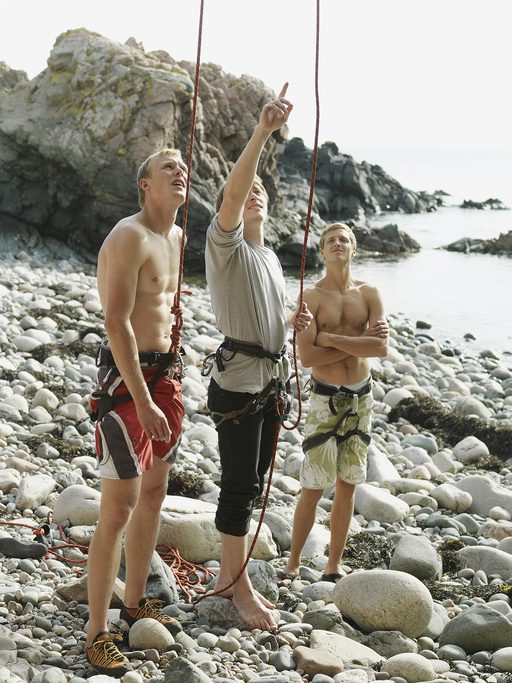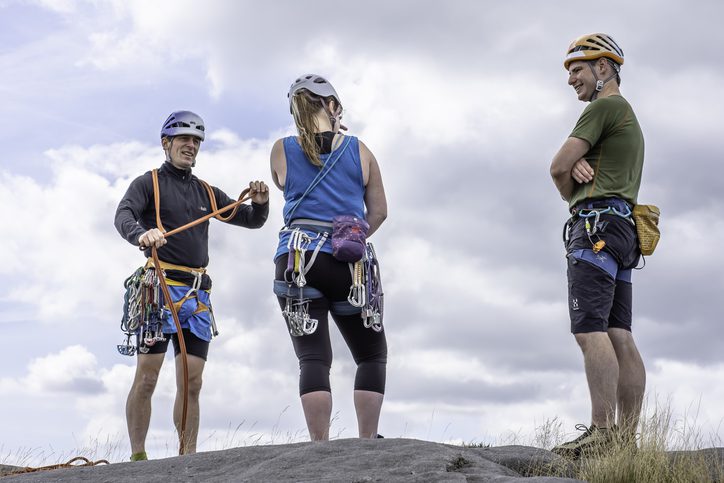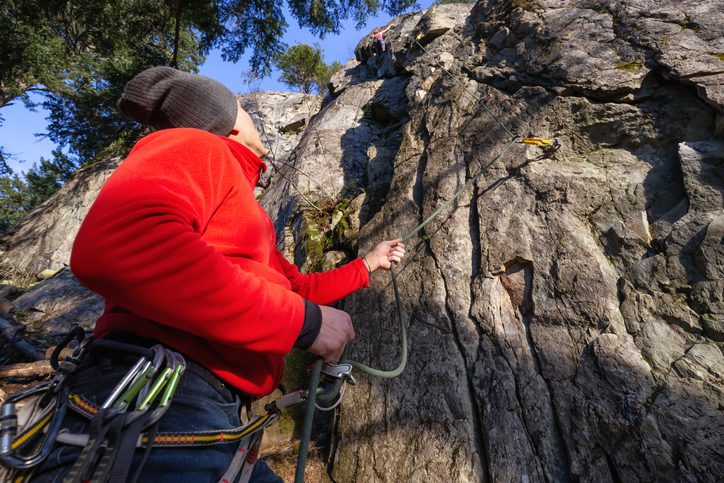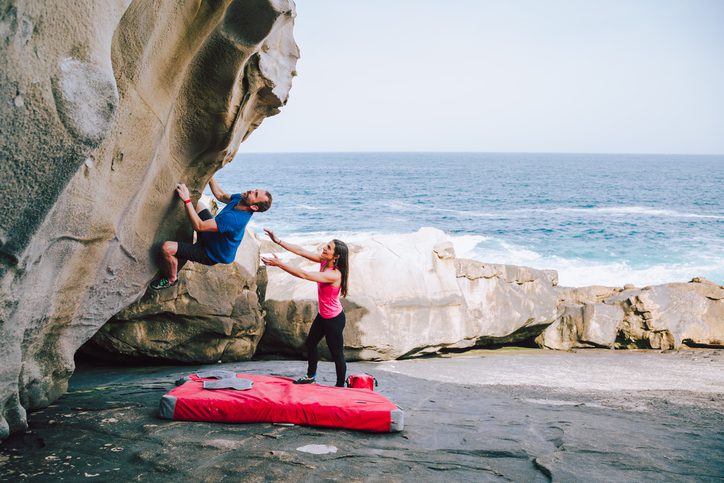Tips to Start Climbing Outdoors this Summer
"The most dangerous part of sport climbing for some climbers is cleaning the anchors. Learn how to do this without detaching yourself from the climbing rope. Practice it often at a practice station"
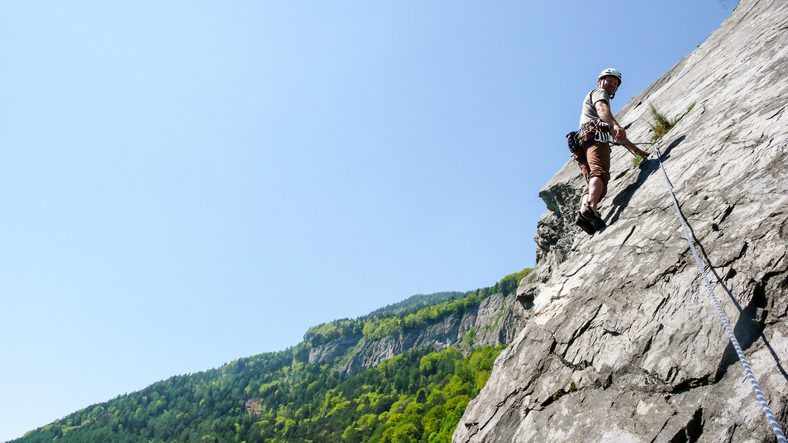
If you’ve learned to climb in a gym, you are probably curious about how to start climbing outside on real rock. This article will tell you what you need to know and the gear you’ll need to make your outdoor climbing experiences safe, fun and in harmony with the ethics and traditions of our great sport. The next article in this two-part series will put you in the know about crag etiquette and climbing traditions of leave no-trace ethics
How to be Safe on the Rocks
Rock climbing started outside and there’s nothing like the feel of real rock and the challenge of a climb on natural rock. You’ll be able to use the strength you developed in the gym, some of your footwork and movement and even some of your safety and ropework skills in the outdoors. But there are quite a few new skills to learn. There are three main ways of learning how to climb outside:
Mentorship: Mentorship is one of the oldest and most popular ways to learn how to rock climb. If you know someone who is experienced at outdoor climbing, ask them to take you. Learning one-to-one in this casual setting can be the best way to learn to climb.
Introduce yourself to people at the gym. The best climber in the gym may not be an experienced outdoor climber at all. Find out who really knows how to climb outside and introduce yourself. Take note that the best way to get your plans cancelled is to also invite six of your other gym climbing friends. Mentors may welcome the opportunity to help out a fellow climber like they were helped once, but will feel taken advantage of if you treat them like unpaid climbing guides or instructors.
Climbing mentors often turn into great friends, and you will never be able to pay a good mentor back for the help they gave you, but gas money and beer are a start.
Many mentors have been surprised by the lack of basic equipment people have before they ask to go outside. Make sure you own your own harness and shoes. If you have a rope, bring it and offer to use it instead of your mentor’s. It’s also a good idea to invest in your own belay device. In sport climbing areas the usual device is the Petzl Gri Gri, at some areas, belay-rappel devices like the Black Diamond ATC are preferred. Ask your mentor what they prefer and have your own and know how to use it. Finally, buy and use a helmet (more on this below).
Don’t be disheartened, however, if you can’t find a mentor in the gym. There are other methods to try, although they offer less certainty. “Finding mentors on our site has worked out really well for folks. What works best is posting using your name and only make plans with people who do the same. Politely ask questions about their experience and skill level and be honest about your own.”
Another source of mentors and partners are outdoor climbing clubs. Most of the local sections of the Alpine Club of Canada have outdoor climbing trips on which beginner outdoor climbers are welcome. Many climbing festivals also have beginner clinics.
Professional Guides and Instructors: Instructors in the gym may not have any knowledge or experience of outdoor climbing. Folks who teach climbing outdoors as a living are typically up-to-date on the latest techniques. Outdoor climbing instructors and guides (or at least ones you should hire) are experts on the risks and techniques of climbing outdoors.
Choose a school or instructor or guide with a good reputation, and certification from the ACMG (Association of Canadian Mountain Guides). Learning from a certified instructor can be a denser experience than learning from an amateur mentor. Instructors are professionals have a range of knowledge that extends into local climbing history and traditions, crag etiquette, rescue, first aid and other outdoor skills.
Teach Yourself: If you are a competent lead climber in the gym with a guidebook, lots of information on the differences between indoor and outdoor climbing, climbing etiquette and your own draws, you may be tempted to risk teaching yourself outdoor climbing. If you plan to teach yourself, at least make sure you are aware of the risks and the rules of climbing outdoors. The crag is not the gym in ways that may surprise you. Guide Sean Isaac warns against having too much hubris coming from the gym: “There are three main skill sets that are required for outdoor rock climbing: movement skills, technical systems and hazard management. The climbing gym only trains one of these equally important categories—movement skills. Technical systems are minimal (indoor top rope and lead belay, clipping and that’s about it) and hazard management is non-existent (i.e. rock fall, weather, exposure, route-finding, wildlife, rescue skills, emergency equipment, etc)”
How to Have Fun on the Rocks
Avoid Ignorance: Come Equipped with Knowledge: Coming equipped begins with being equipped with knowledge. Show your respect for the local climbing and the people introducing you to it by buying the guidebook and reading about the local climbs. Most guidebooks have a section at the beginning about local climbing rules, access and traditions. This is important information.
Read up as much as you can on safety techniques and the differences between the crag and the gym. There are lots of great books available. There are many internet resources as well, ranging from what not to do videos to clips showing how to perform virtually any rock climbing technique carefully made by guides. Here’s some great advice from Tommy Caldwell, one of the world’s most accomplished climbers.
Treat the Rock and Bolts With Respect: Your gear choices are even more important outside than inside. Buy a good helmet and always wear it. Outdoors, the risk of hitting your head against the wall in the case of a fall is higher than it is in a gym. Even more important the risk represented by rockfall. Most new outdoor climbers are surprised by the fact that rock is not as reliable as the holds in gyms. Although making chalk “X”s on rattly or fragile-looking holds does not change the fact that holds come off and rockfall is a regular occurrence at cliffs. Invest in a good helmet, be aware that children, who also need helmets, and pets left at the base of the cliff are also vulnerable to rockfall.
The routes in the gym are set by paid employees with your climbing pleasure in mind. Routes outdoors are set by passionate climbers who donate their time and money for bolts to make them and who follow their own vision of climbing. Without their work, there would be no climbs, so thank them if you ever meet them and remember, climbing outside, there is no front desk to complain to and you are responsible for your choices. Remember, gravity never sleeps, be vigilant and deliberate in your choices at all times. Climbing outside is a great adventure and you are responsible for the safety of you and your partners.
Climb Easy, Belay Hard
Check the knots and belay and harness twice before starting to climb. Start on climbs at least two number grades easier than you are climbing in the gym. Outdoor belaying is not backed up with mats and is a skill that must be constantly adapted to each different belaying situation. Make sure you always tie a knot in the end of the rope so that when you are lowering the climber, it cannot accidentally slip through the belay device with potentially serious results. The belayer should stand close to the face, directly beneath the climber to be safely be pulled straight upwards if they catch a fall.
Communicate sparely and accurately with commands both climbers know. Use the belayer’s name at crowded crags to avoid confusion. Learn how to clean an anchor safely. Sean Isaac warns against the over-use and misuse of personal tethers in lieu of proper ropework.
The most dangerous part of sport climbing for some climbers is cleaning the anchors. Learn how to do this without detaching yourself from the climbing rope. Practice it often at a practice station.
It isn’t enough to master all of the technical aspects of climbing, however. Whole areas popular with superb, safe climbers have been shut down by landowners because the user did not know climbing etiquette and outdoor ethics, or simply didn’t care. Our next installment will deal with aspects of climbing that are strictly relevant to the outdoors and essential to your enjoyment, safety and continuing access to the cliffs: etiquette, environment and ethics.
Bouldering
The good news is that you can skip learning rope work, belaying and all of those skills and have lots of fun bouldering. Bouldering, however, has some risks. Buy a bouldering pad, and learn to use it properly, learn to be a good spotter, and know how to fall safely, minimize injuries while you climb and you can enjoy one of the most popular kinds of climbing.
As you increase your ability, however, you’ll probably want to get shoes appropriate for bouldering. These are typically thinner-soled, more sensitive and supplied with ample rubber for smearing. Most boulderers now share a chalk bucket. It’s easier to use and lessens the chance of spilling chalk all over the base when you fall.
Have a Bouldering Pad and a Brush: Use a bouldering pad to minimize impacts. Position it beneath where you think the crux will be. The placement of a bouldering pad is an art that involves assessing the risks to a fallen climber- a sharp rock beneath where they’re climbing, a dip in the ground that could twist an ankle – and moving the pad so that it is always offering the most protection to the climber. Use a brush to clean any built up chalk or sweat from the holds both to minimize impact and to give you the best chance of gripping any well-used holds.
Fall Right: Always try to fall on your feet. Even if you come off when you didn’t expect to, try to get your feet underneath you. Avoid doing moves like high heel hooks that will lead to an uncontrollable fall until you are more experienced.
Spot Right: The job of the spotter is not to grab a falling climber but to try to direct them so that they land feet first, away from nasty rocks or other hazards. Your spotting, like belaying, will improve with experience. Stand behind the climber, aware of what you are trying to achieve when they land, hold your hands up, but keep your fingers together and fold your thumbs into your palms to avoid a finger injury. There are various schools of the catch but the most reliable is right under the armpits.
Injury Avoidance: Boulder problems have far more difficult climbing per move than most rock climbs. Warm up on easier problems before trying the hard ones. Be aware that many modern bouldering problems in gyms have big, ergonomically friendly holds, but outdoors, crimps, pockets and dynos in no way friendly to your shoulders await. Build up your strength, ability and agility slowly and you’ll avoid finger, elbow or shoulder injuries that could keep you away from the boulders for months. Training devices will help you increase your strength, which is crucial to avoiding injury.
